Love it or hate it, abstract sculpture has become a fixture of the art scene in the UK and around the world. Barbara Hepworth (1903-1975) was one of the figures who helped make abstract art what it is today. One of Britain’s foremost abstract sculptors, Hepworth shaped the art form in the post-war years and, along with Henry Moore, helped popularise modernist art. She was one of the most famous members of the St Ives School, a group of artists based in a coastal town in Cornwall, and many of her works were inspired by the Cornish coastline.1
Denis Mitchell (1912-1993) was another artist and became Hepworth’s assistant in 1949 after being recommended to her by Bernard Leach, a renowned potter who also lived in St Ives. Mitchell would work for Hepworth, helping to carve her sculptures, until a decade later in 1959.2 Hepworth was the one who encouraged Mitchell to turn to sculpture rather than painting,3 and there are strong similarities between their works. He became an art teacher and an abstract sculptor in his own right, but never reached the same level of success as Hepworth.
It is interesting to see where Hepworth and Mitchell’s art holds the same inspiration and where it diverges. The two artists had many forms which they used, likely thanks to Hepworth’s intervention (explicitly or otherwise) in the development of Mitchell’s sculpture. Here I take a cursory glance at these overlapping forms, looking at three in particular. These are the pierced form (where a hole is made through a sculpture), the theme of the divided circle, and the ‘upward prongs’ motif (where horn- or spike-like forms protrude from the sculpture). Both Hepworth and Mitchell brought their own interpretation to each form, making it interesting to compare their different styles.
Pierced Forms
The pierced form was undoubtedly a hallmark of Hepworth’s work and one of her greatest innovations. Her first pierced sculpture was Pierced Form, a since-destroyed 1932 piece.According to the Tate, the pierced form became an “essential element” of her artistic life.4 Hepworth herself said that they had given her “sufficient field for exploration to last a lifetime”.5
Hepworth is credited as the sculptor to first introduce the idea,6 cementing her influence over modern sculpture. She saw the introduction of negative space both as a story in itself and also vital in creating both ‘inner’ and ‘outer’ forms.
With Hepworth using such a novel form, it is unsurprising that Mitchell adopted it. He also pierced his sculptures, but in a different way to Hepworth. Hepworth’s simple circular inner forms such as those in Square with Two Circles evolve into the thermometer-like negative shapes which frequent Mitchell’s work and are seen in Polzeath and Talmore (see pictures below). The vertical lines created in the negative space lend themselves particularly well to Mitchell’s tall, thin sculptures. The different way that Hepworth and Mitchell incorporate negative space within their art contributes to their distinct styles.
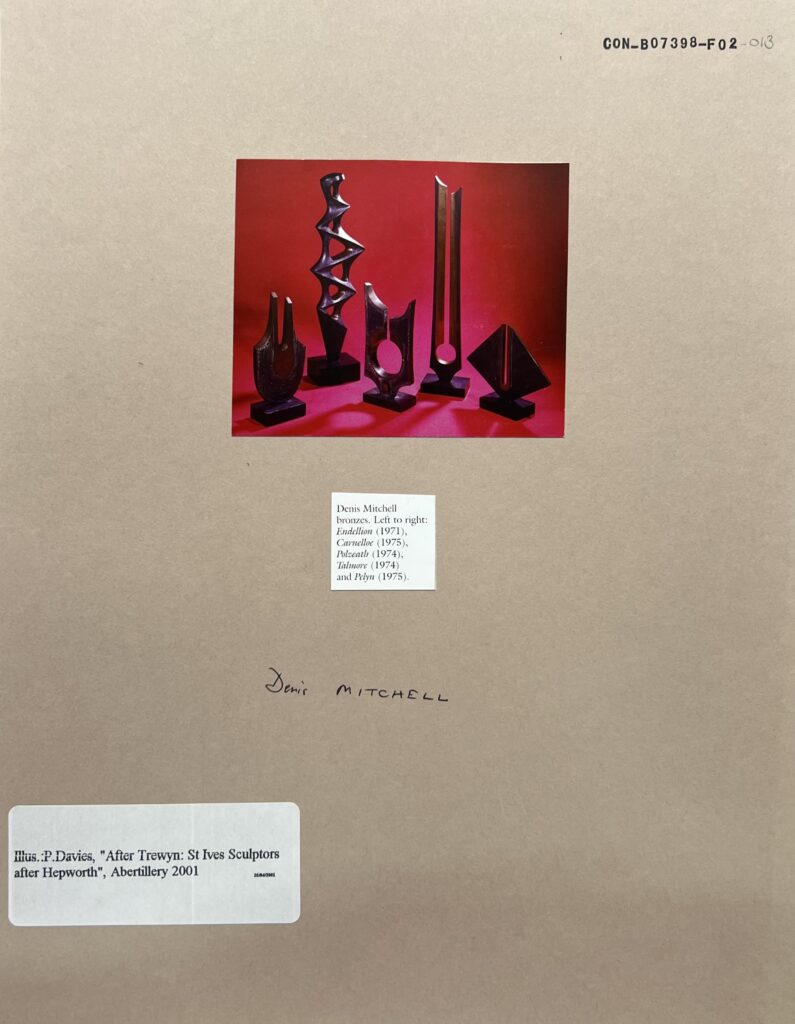
Five bronze abstract sculptures by Denis Mitchell stand against a red background. The two taller, thinner sculptures are arranged behind the three shorter sculptures. They are lit from the right and cast soft shadows towards the bottom left of the picture. [Denis Mitchell bronzes. Left to right: Endellion (1971), Carnelloe (1975), Polzeath (1974), Talmore (1974) and Pelyn (1975). Attribution: P. Davies. CON_B07398_F02_013. The Conway Library, The Courtauld Institute of Art, CC-BY-NC]

A black and white photograph of a bronze abstract sculpture by Barbara Hepworth. The sculpture is made of a rectangle with a hole through its left side on top of a square with a hole through its right side which stands upon a smaller rectangle joined to a plinth. The top rectangle has a lighter finish than the rest of the piece. ‘Square with Two Circles’ (1963) by Barbara Hepworth. Attribution: Tate Gallery. CON_B07282_F01_045. The Conway Library, The Courtauld Institute of Art, CC-BY-NC]
Divided Circle
The divided circle was an important motif for both Hepworth and Mitchell and it became a recurring feature of their art. The complexity of this idea meant that there was opportunity for experimentation – the shape could be seen as both one circle or two separate parts.
Hepworth’s circles were often divided through physical separation such as with Two Forms (Divided Circle). Each half of the circle has its own details – both are pierced, but with holes of different sizes and differently-shaped indents. This creates a sculpture which embodies the concept of the divided circle. The two halves can be seen independently, as forms in their own right, or together, making a unified circle.
Mitchell, however, shows the different ways the circle can be divided while still remaining one object in his Variations on a Theme No.1 through to No.5. In Variation on a Theme No.2, the circle is divided at the front of the sculpture but attached at the back, making a figurative but not literal division. In Luxulyan, another work by Mitchell, he makes the division by polishing one half of the circle and creating a patina on the other. The progression of the idea through from literal separation, to partly divided, to only a visual division shows an interesting evolution between the work of Hepworth and that of Mitchell.
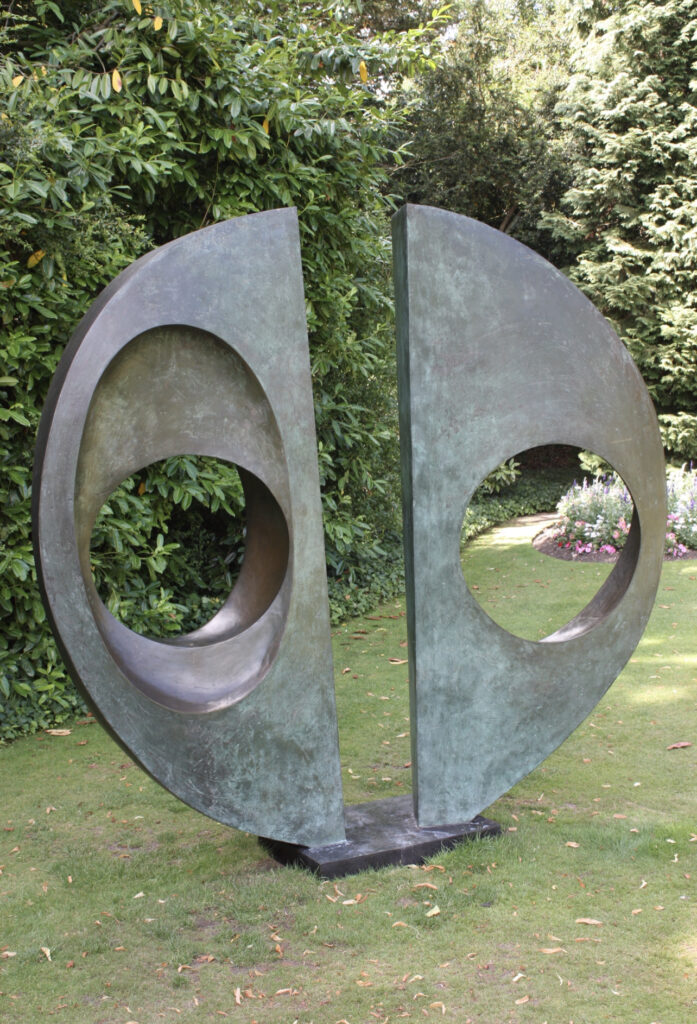
An abstract bronze sculpture by Barbara Hepworth photographed in a garden. The sculpture is two separate halves of a circle, each with a circular hole in them, offset from one another slightly and attaching to a plinth at the ground. ‘Two Forms (Divided Circle)’ by Barbara Hepworth. Attribution: “Clare College, Cambridge, July 2010 (03)” by Ardfern on Wikimedia Commons, CC-BY-SA 3.0]
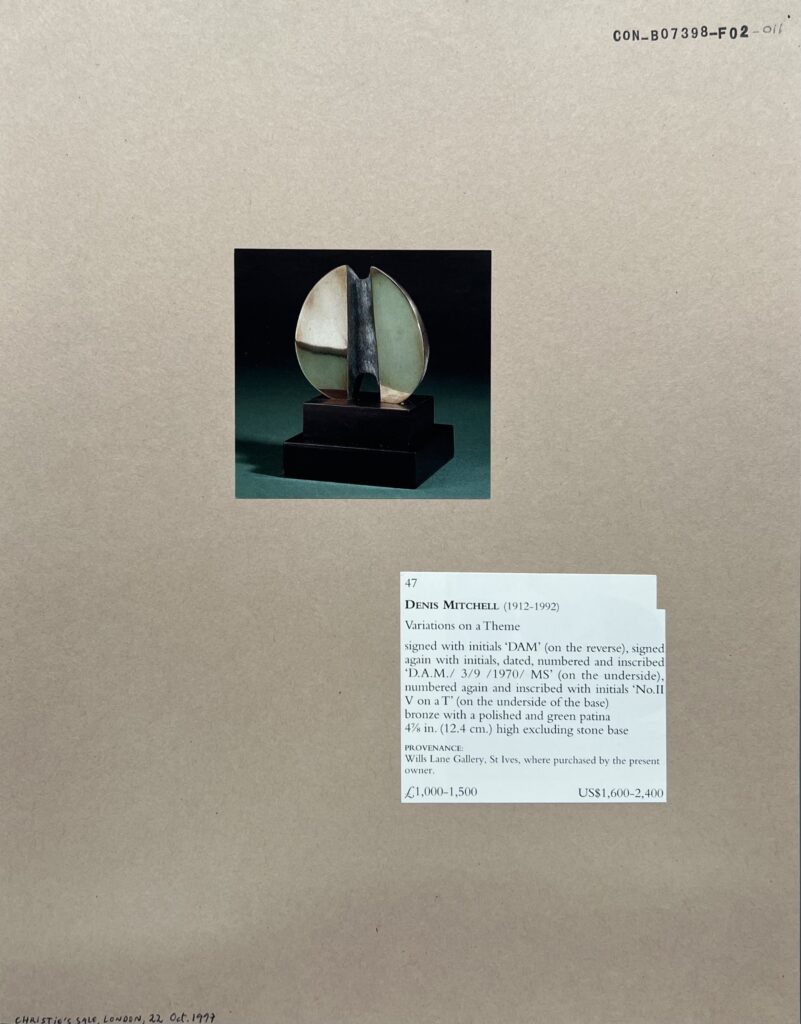
An abstract bronze sculpture by Denis Mitchell on a black plinth sitting on a teal surface that fades to a black background. The sculpture is a circle roughly divided in half and separated except for a connection at the back of the sculpture. The faces of the halves are polished while the connection has a patina. Variations on a Theme No. 2 by Denis Mitchell. Attribution: Christie’s. CON_B07398_F02_011. The Conway Library, The Courtauld Institute of Art, CC-BY-NC]
‘Upward Prongs’
One of the forms that was especially key to Mitchell’s style was ‘upward prongs’. These prongs become an aspiring form, giving his sculptures a noticeable dynamism. In Gemini (pictured below), one of Mitchell’s marble sculptures, the prongs give a lighter feel to the material by reaching away from the main body of the work. The prong motif can also be seen in the thinner, needle-like spires such as in Porthcressa and Thrust. In some sculptures, like Widdon, one of the prongs is removed altogether, resulting in an elegant droplet shape. These prongs and spikes are characteristic of Mitchell’s work, but they also make appearances in Hepworth’s sculpture.
Cantate Domino (1958, pictured below) and Stringed Figure (Curlew) (1957) seem the most Mitchell-esque of Hepworth’s pieces. These types of ascending, open-ended sculptures that she made in the last half of the 1950s form a particular period in her career and are among her most dynamic works. As they were produced in the last years of Mitchell being Hepworth’s assistant, it is reasonable to expect that he chose this particular form to explore further.
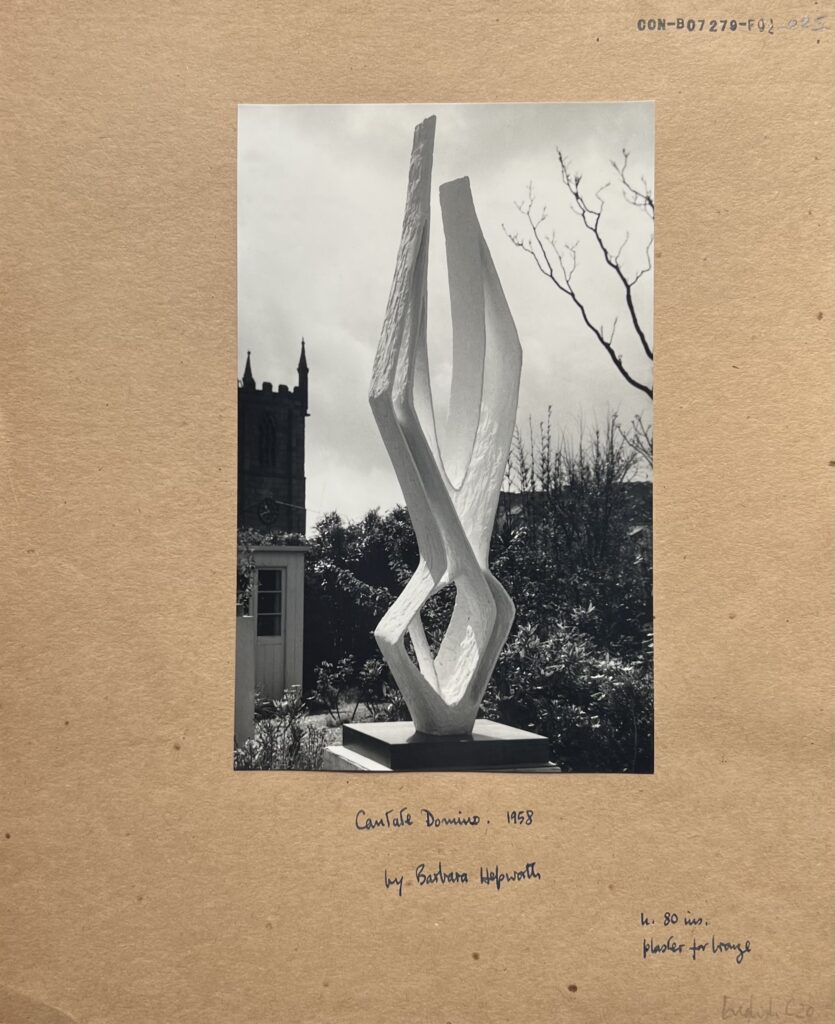
A black and white photograph of a white plaster model for a sculpture sitting on a plinth. The picture has been taken in a garden and a church tower can be seen in the background. The sculpture is two diamond shapes on top of one another made from flat strips of material. The upper diamond is not closed at the top, and the front and back of the sculpture are left open so it is possible to see through parts of it. Plaster model for ‘Cantate Domino’ (1958) by Barbara Hepworth. CON_B07279_F02_025. The Conway Library, The Courtauld Institute of Art, CC-BY-NC]
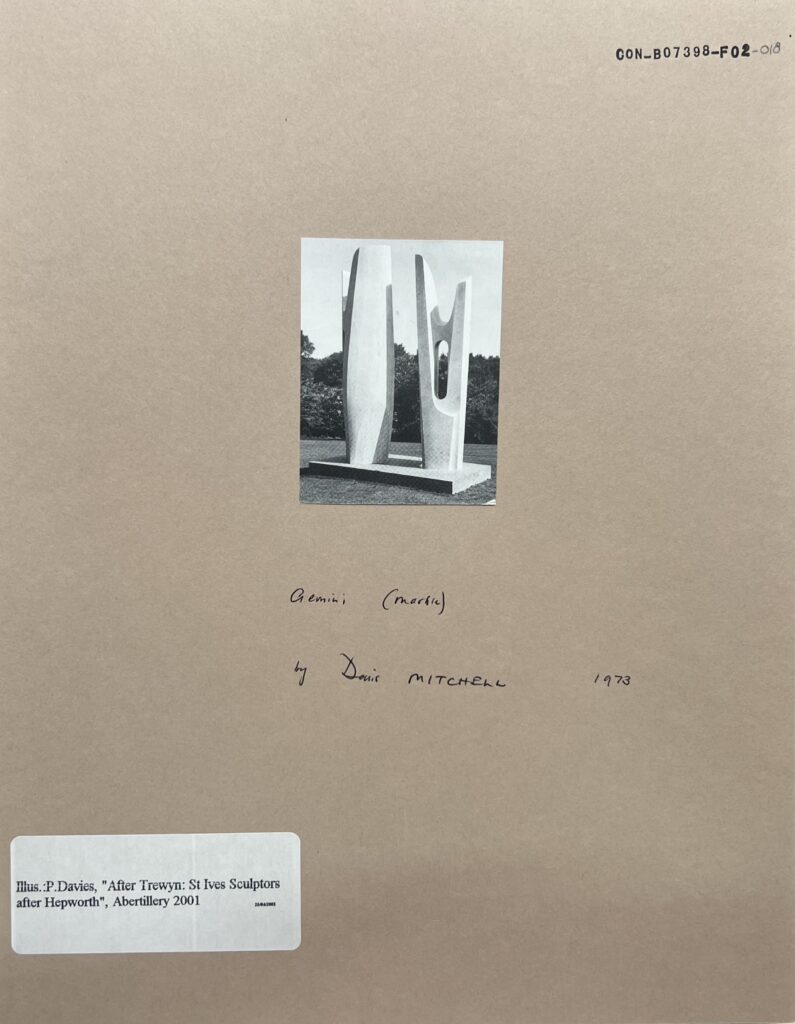 A black and white photograph of a marble sculpture taken outside. The sculpture is two upright forms angled such that only the one on the right is facing the camera. The sculptures have oval-shaped holes in them and ‘prongs’ rising out of the top. ‘Gemini’ (1973) by Denis Mitchell. Attribution: P. Davies. CON_B07279_F02_025. The Conway Library, The Courtauld Institute of Art, CC-BY-NC]
A black and white photograph of a marble sculpture taken outside. The sculpture is two upright forms angled such that only the one on the right is facing the camera. The sculptures have oval-shaped holes in them and ‘prongs’ rising out of the top. ‘Gemini’ (1973) by Denis Mitchell. Attribution: P. Davies. CON_B07279_F02_025. The Conway Library, The Courtauld Institute of Art, CC-BY-NC]
Even in the motifs and forms which they both used there are noticeable differences between the art of Hepworth and Mitchell, showing the breadth of their combined creative exploration. It is precisely where their styles diverge that both Mitchell and Hepworth find their niche; much more could be said about this, though it falls outside the scope of this blog post. In a more general sense, Mitchell and Hepworth’s work with similar forms shows how the same abstract techniques and motifs can be used in different ways by different artists. It is exactly this that gives abstract art its potential and is the reason that it continues to develop to this day.
Bibliography
Tim Adams (7 June 2015), “Barbara Hepworth: A life told in six works”<https://www.theguardian.com/artanddesign/2015/jun/07/barbara-hepworth-life-in-six-works-tate-retrospective-exhibition-sculpture-for-a-modern-world>, The Guardian, accessed June 2023
John Halkes (25 March 1993), “Obituary: Denis Mitchell”<https://www.independent.co.uk/news/people/obituary-denis-mitchell-1499773.html>, The Independent, accessed June 2023
Sothebys.com <https://www.sothebys.com/bsp-api/lot/details?itemId=a7649144-1d77-401e-b4da-b68625595342>, accessed June 2023
“Pierced Form”<https://www.tate.org.uk/art/artworks/hepworth-pierced-form-t00704>, Tate, accessed June 2023
Ruthie Collins (3 January 2020), “Divided Circle”<https://cambsedition.co.uk/arts-culture/divided-circle/>, Cambridge Edition, accessed June 2023
Giselle Au-Nhien Nguyen (25 November 2022), “Of stone and wood: sculptor Barbara Hepworth steps out of Henry Moore’s shadow”<https://www.theguardian.com/artanddesign/2022/nov/26/of-stone-and-wood-sculptor-barbara-hepworth-steps-out-of-henry-moores-shadow>, The Guardian, accessed June 2023
Billy Warren
Courtauld Connects Digitisation
Oxford University
Micro-Internship Participant

